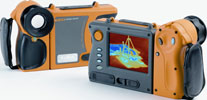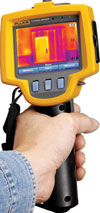

Mexican airports have purchased thermal imagers to help in the drive to prevent the spread of diseases, such as swine flu.
Airport officials in Mexico have invested nearly a half a million dollars in purchasing thermal imagers (infrared cameras) from Fluke Corporation, a subsidiary of Danaher Corporation to help them screen people for H1N1 influenza A, or swine flu.
The portable infrared thermal imagers enable airport, transit, public health officials and others to quickly scan and measure the skin temperature of large numbers of people. Those who show temperatures higher than normal can then be isolated for further evaluation to help prevent the spread of disease. The imagers are in use at airports across Mexico, including Benito Juarez, in Mexico City. Dominion, a system integrator and the Fluke representative for Mexico, has worked with airport officials to provide training and consulting services to ensure high quality screening.
The outbreak of H1N1 flu in Mexico has devastated tourism. Mainstream press has reported that hotel occupancy rates in Mexico City (with a population of 20 million residents) are at record lows of between 5 and 7%. Mexican authorities have responded decisively to control the outbreak, shutting down buildings and public events. International experts have praised Mexico’s actions. Reuters reported recently that “many experts believe Mexico’s apparently quick and forceful actions could keep people safer in other countries.” Passenger screening with thermal imagers is one such action. The Chronicle said that “The Cancun airport is using infrared thermometers to detect fevers among arriving passengers.”

How it works
All objects emit infrared (IR) energy, including the human body. IR non-contact thermal imagers use IR emissions to measure surface temperature, including the temperature of skin, which is displayed in colour on the thermal imager’s screen.
Individuals with fevers often have elevated skin temperature. When the imager detects that a person has a skin temperature higher than normal, the instrument can trigger an alarm or light. Those people can then be further tested to determine whether they actually have a fever and/or a communicable illness.
Fluke thermal imagers incorporate Fluke IR Fusion, a user-preferred technology that integrates infrared and visible-light images. IR Fusion helps the operator determine exactly where in the scene a heat source is located, so that individuals with elevated skin temperature can be easily located and pulled aside for further screening. Fluke imagers can detect temperature differences as small as 0,05°C. Fluke thermal imagers also feature the large LCD screens and video output which make them ideal in the use of scanning large groups of people.
To help understand the technology and how to use it to scan large groups, Fluke has put together a brochure called “Infrared Health Screening.” It is available free from the Fluke website at www.fluke.com/fluscreen.
While infrared scanners and thermal imagers are designed for industrial use, this technology can be very beneficial to public health in such locations as:
* Airports, seaports, bus and train stations.
* Hospitals and schools.
* Factories and office buildings.
* Stadium events and conventions.
* Other public gathering areas.
As screening tools, Fluke infrared thermal imagers have many benefits:
* Non-contact screening reduces the chance of spreading infection or disease.
* Fast temperature readings mean large groups of people can be screened quickly.
* IR Fusion technology provides screeners with a visible light image (digital picture) of the crowd so that individuals with elevated body surface temperature are easy to identify, making screening quicker and more efficient.
* Infrared temperature measurement is completely safe and non-invasive, so there is no risk to public safety or privacy.
* People can be screened while moving, so travel is not delayed.
In addition to such public health applications, Fluke Thermal Imagers are invaluable tools to detect moisture damage and missing insulation, identify energy losses, inspect roofing, inspect electrical and mechanical equipment and for many other everyday troubleshooting and maintenance tasks. In addition to handheld imagers, Fluke also offers fixed-mount thermal scanners through its Raytek and Ircon companies.
Comtest is Fluke’s accredited partner in southern Africa for Fluke Industrial and Electrical test tools and Fluke Precision Measurement. Fluke’s Hart Scientific division supplies measurement laboratories with temperature standards for measuring temperature and humidity.
For more information contact Val Verwer, Comtest, +27 (0)11 254 2200, [email protected], www.comtest.co.za
| Tel: | +27 10 595 1824 |
| Email: | [email protected] |
| www: | www.comtest.co.za |
| Articles: | More information and articles about Comtest |
© Technews Publishing (Pty) Ltd | All Rights Reserved